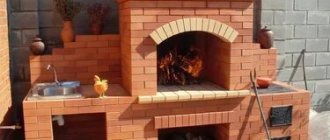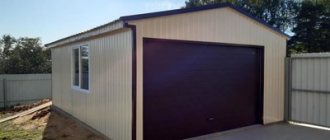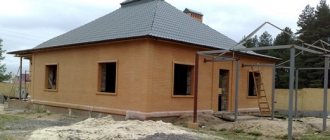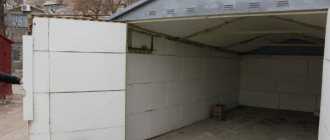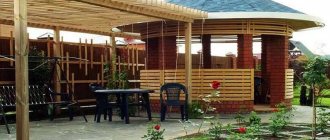Building a brick garage with your own hands
Each car needs a room for permanent or temporary storage, which will protect the vehicle from the scorching rays of the sun or winter frosts. The best place for this is a full-fledged garage, which you can build yourself or involve specialists in the work.
In this article we will give useful tips and tell you how to build a brick garage with your own hands, without experience and without making serious mistakes.
Types of garages
The main and most popular material for building a garage is brick. It is fireproof, has good strength and is resistant to various negative weather influences. Do-it-yourself brick garage - this is exactly the kind of construction that will be discussed in detail today.
Drawing of a brick garage.
The first thing you need to decide is the type of construction. How many cars will be placed in it, the possibility of placement, the availability of free space, and so on - you need to think about all the nuances and choose one of the following types of brick garages:
- separate building;
- built into housing;
- extension to the house.
A separate building is the most popular option. It is being built as a separate building, electricity, heating and water supply (if necessary) is also its own. Buildings of this type are usually located in the most comfortable place for entering and exiting the yard.
The best option is in line with the fence, at the level of the site, so that the gate of the building goes directly to the road.
Built into the house. A garage of this type is planned initially and is built along with the house. Among the advantages of this type of construction, it is worth noting the ease of entry - directly from the house, as well as the absence of the need to lay additional communications.
Extensions to the house. They are also very convenient, since they can be entered both from the front and from the side, directly from the home. Another plus is that they are heated together with the home thanks to a common water supply and power supply system.
In view of the demand for the first type - a separate building, it will be considered in detail.
Gate installation
Gate hinges
For garages, both sliding and swing gates are acceptable. First you need to weld the door frame to the garage slopes. This must be done clearly at the level so that there are no distortions in the structure. Next, we weld the hinges to the frame; gates made from a frame covered with sheets of metal can now be placed on them. Let us remind you that the gates should be insulated with polystyrene foam.
Article on the topic: What should be the distance from the garage to the residential building
It is worthwhile to prepare well theoretically before starting independent work on constructing a garage.
Drawing of a swing gate
Garage project
Natural ventilation scheme
Gate stiffeners
Construction of a monolithic foundation
Garage attached to the house
Gate insulation
The first stage is the project
The construction of any building begins with planning, and a brick garage will be no exception. A project is not always a huge roll of paper with many detailed drawings on it. It is important to simply understand what needs to be built and how.
Sometimes an ordinary piece of notebook paper on which the future structure is drawn is enough. The main thing is the guideline that you will follow.
The first thing that needs to be taken into account at the design stage is the tasks that the building will perform. Will it be used only for car parking, or will vehicle repairs and repair work be carried out there? Will there be a cellar, inspection hole or attic in it? All this should be taken into account and recorded on paper.
Garage standards
Let's start with the size of garage buildings, depending on the dimensions of the car for which they are being built. There are so-called minimum standards, which are characterized by the distance from the machine to the internal surfaces of the walls of the building.
- The width of the building is the width of the car plus 70 cm on each side.
- Length is the length of the car, plus 50 cm on each side, measured from the bumpers.
- Garage height for a passenger car: 2-2.5 m, for a truck – the height of the car, plus half a meter.
For passenger cars, the optimal dimensions of the building are: length 6 m, width 4 m, height 2.1-2.5 m. We take them as the basis for our story. Of course, these are just the minimum parameters. That is, garages can be built wider and longer, two- or three-story. It all depends on the customer’s requirements; there are no other selection criteria.
A mandatory communication network that simply must be present in the garage is electrical. To do this, it is necessary to install a distribution panel inside the building, from which a lighting cable and a separate line to the sockets are diverted. The first section is usually equipped with four lamps: two ceiling and two side. The second is either 2 or 4 sockets.
Standard red brick garage 6x4 m Source youla.ru
It is possible to install water supply into the garage and, accordingly, sewerage. This is a serious bonus in increasing the comfortable maintenance of the car.
As for the inspection pit, everyone has recently abandoned this building element. The thing is that repairing modern cars is the work of professionals who use special equipment and tools for diagnostics and repairs. The only thing you can do inside your own garage is to recharge the battery. And for this purpose an inspection hole is not needed.
Second stage - marking
The drawing of the future brick garage is ready, now its dimensions need to be oriented on the ground. For this you will need:
- long tape measure;
- sledgehammer or heavy hammer;
- 10-15 pegs about 40 centimeters long;
- about 40 meters of durable cord.
All the tools are ready - we clear the place for construction. Next, focusing on the garage drawing, we hammer stakes into the corners of the future building according to the dimensions, and then connect them with a cord. The result obtained will become a guideline for the construction of the garage.
Material calculation
Before construction, be sure to calculate the amount of building materials that will be needed to create a garage. The amount of materials used directly depends on the size of the future garage structure.
To determine how much building materials you need to buy, you will have to:
- calculate the volume of the walls based on their length and width;
- determine the volume of window openings, doors and gates;
- calculate the volume of brick laying;
- determine the amount of building materials based on the results of the calculations made.
The third stage - earthworks
According to the markings, it is necessary to dig a trench in the ground for the foundation. If the garage is simple, you can get by with an ordinary shovel. If it contains a pit or cellar, it is better to use the services of an excavator.
For a do-it-yourself brick garage, a conventional strip foundation with a width of at least 40 centimeters is quite sufficient. Depending on the terrain and soil freezing during cold seasons, the depth can range from 60 to 12 centimeters. The optimal depth is one meter.
The walls of the dug trench must be smooth and vertical, the bottom must be solid. To improve the quality of the final foundation, it would be useful to pour a cushion of sand or crushed stone 5-10 centimeters thick at the bottom and compact it thoroughly.
Stage four - pouring the foundation
An affordable and simple foundation, optimal for pouring a garage, is rubble concrete. It is done very simply - rubble stone is laid in rows in a finished trench, after which each row is filled with cement mortar. And so on until the very top is filled.
A properly made foundation is the key to the durability of the garage, since the likelihood of cracks and the degree of shrinkage of the building itself depends on its quality. For this reason, when making a brick garage project and bringing it to life, you should not skimp on materials.
For the solution, the highest available grade of cement, water, plasticizer and sand are used. To make mixing easier and increase the speed of work, it is better to use a concrete mixer.
Approximate ratio of components for high-quality concrete:
- 10 kg of cement;
- 30 kg of sand;
- 40-50 kg of crushed stone or gravel.
Add water, focusing on the desired consistency of the solution.
You can fill the foundation without using rubble stones, but then you will need more mortar, and you need to add reinforcing mesh in the trench itself.
Repair of cracks and other defects
Before starting repairs, it is necessary to establish the causes of cracks in order to avoid recurrence of the problem. Most often, strengthening the walls, the process of which was described above, helps eliminate the cause.
Possible reasons:
incorrect masonry construction technology, weight redistribution occurred unevenly;- use of low-quality building materials;
- shrinkage of the garage, which led to deformation of the building;
- lack or poor quality waterproofing;
- frosts, unfavorable climatic conditions;
- human factor (saving solution, inexperience).
Stages of repairing garage walls:
- If cracks have formed in the seams, the mortar has crumbled and voids have appeared, you need to clean the area with a stiff brush and treat it with a primer. After the gap is filled with a small amount of solution, reinforcement is placed inside with pressure. Finally, the solution is tightly driven into the gap and leveled.
- Small cracks in the wall just need to be cleaned and sealed tightly with mortar.
- Explore large cracks, find the beginning and end. Install metal brackets in the upper and lower parts (drill holes at a distance of 6-10 cm from the edge of the crack, drive in dowels with metal strips); if the split is long, you can make several more ties along the entire length. Clean and prime the cracks, pack them tightly with the solution; you can use a syringe for this.
If the crack is wide and deep, use foam or silicone sealant to seal it.
Fifth stage - laying walls
Scheme for creating a brick wall.
A month has passed - the foundation has completely dried out, and you can start laying the walls. Depending on the region, you can take a thickness of one and a half bricks for colder areas, and one brick for areas with a warm climate.
When installing, it is important to follow several rules:
- No distortions - the masonry must be extremely even.
- Having decided on the scheme for laying sand-lime bricks, stick to it until the work is completed.
- The mixing of the solution must be correct and the same throughout the entire work. Once you have chosen the ideal proportion, maintain it constantly.
- The thickness of the seam should not be more than one centimeter. For ease of laying, you can use a sample strip 8 millimeters thick when laying out the bricks.
To work you will need:
- shovel;
- buckets;
- a large capacity container for mixing mortar or a concrete mixer;
- pick;
- bricks;
- Master OK;
- fishing line or lace;
- plumb line;
- building level.
To build walls, chain masonry is used, when one row of bricks overlaps the seams of another row. In the outer row you can use facing bricks. It is necessary to start laying from the corners, laying them out using a building level.
Next, a fishing line is stretched between the resulting angles. It should be flush with the top of the brick. It is important that the lace is pulled tight enough and does not sag.
Now you can begin the laying itself. New rows of bricks are placed from the corners flush with the line, adjustment is carried out using a pick or trowel. After the row is laid along the perimeter, the lace rises to the level of the next brick and the work continues.
We pay special attention to the corners and the strictly vertical level of the walls, for which we use a plumb line.
If the roof is planned with one slope, it is necessary to ensure the required level of slope for water drainage. To do this, we make the height of the end walls different, and the upper cut of the side walls is inclined. For example, for a garage six meters long, the normal tilt angle is approximately 30 centimeters.
To do this, a slope of five centimeters is made on every meter of the slope. To maintain the normal level of the slope, you can use a cord.
Video description
The video shows the technology for forming a wooden garage floor with subsequent installation of corrugated sheeting:
Roof
At this stage it is necessary to erect the roof. With gable and single-pitch structures, everything is more or less clear. As for the flat roof. In principle, screed mortar must be poured onto the floor slabs so that it creates an inclination angle of no more than 5°. And the roofing material is laid on this dried surface. Most often it is a roll type, but you can also install corrugated sheeting by laying a thin sheathing of boards 100 mm wide underneath it.
Laying rolled roofing material over a poured screed Source moydom.net.ua
Stage seven - pouring the floor
Self-leveling flooring and concrete subflooring are the two main types of flooring most often used in garages.
To install a concrete floor, the top layer of soil in the room is removed, a layer of sand about 10 centimeters thick is poured in and compacted tightly. To prevent water entering the garage from lingering on the floor, you can make a slight slope towards the gate, about 2-3 degrees.
After compacting the sand, a waterproofing coating is laid on it (roofing felt works well), and a concrete screed about 10-15 centimeters thick is made.
Important! The garage floor must be strong and resistant to stress, so it should be reinforced with reinforced mesh. The grade of concrete for the floor is also as high as possible.
Brickwork drawing.
As an alternative flooring option, some use wood, but cement screed is still most often used. To complete this, the site is covered with large and small crushed stone, compacted well and cement mortar is poured in two stages.
The first layer, about five centimeters thick, is poured immediately, after which it must be allowed to dry for several days. The second layer is twice as thin and is much less dense. It is leveled and waited for complete drying.
Self-leveling mixtures, which can be used instead of a second layer, are now becoming increasingly popular.
A blind area of half a meter is made outside. It is done similarly to the internal floor; a thickness of about five centimeters is sufficient. Its purpose is to drain liquid, so we maintain the slope.
That's it, the construction of the garage is complete. If desired, the walls are plastered and whitewashed by electricians after installation.
Roof structure
When building a garage, pitched roofs are especially popular. This is a cheap and practical option for installing the upper part of the building. To make a pitched roof, care should be taken about its construction at the stage of erecting the walls, so the opposite end walls must be of different heights. For a garage 6 meters long, it is optimal to make the tilt angle 50 degrees. This can be achieved by making a slope of 5 centimeters for every meter of long walls. To visually assess the angle of inclination, you can pull a rope by connecting the ends of the building.
When installing a roof, wooden beams are required, which should be approximately 0.2 meters longer than the width of the garage. They are laid in increments of 0.8–1 meter, repeating the slope of the walls. Wooden boards are installed on top of the beams. It is important to ensure that there are no gaps between them and to nail them as tightly as possible.
It is necessary to lay waterproofing on the boards, for example, roofing felt. Sheets of material are overlapped and secured with nails. Next, they begin laying the roof. The choice of material is rich. The following types of roofing coverings are used for the garage:
- slate;
- ondulin;
- corrugated sheeting;
- various types of tiles.
All types have a fairly long service life and differ only in price and appearance.
